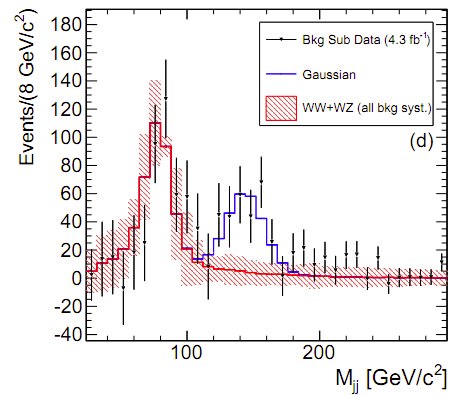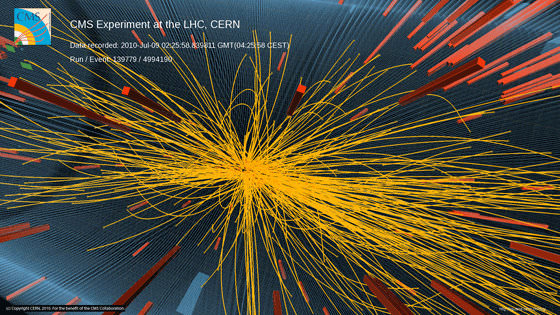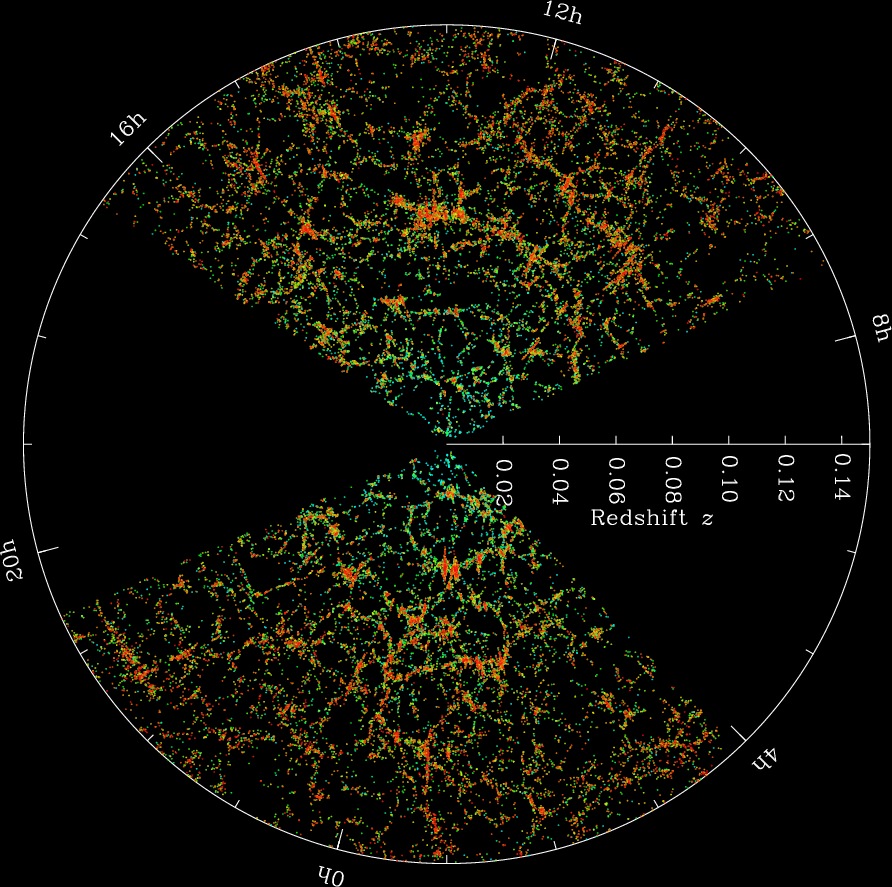Can chocolate cream eggs help explain the mysteries of the Universe? As part of the University of Nottingham’s Sixty Symbols science video series, the Cadbury creme egg has been featured this week, with several eggcellent videos just in time for Easter. This one discusses the cosmological constant, and the possibility of how we might be surrounded by tiny eggs from another dimension. Surprisingly, scientists can explain and demonstrate the some fundamental scientific laws that govern the universe with yummy cream filled chocolate eggs. See more egg-themed discussions at Sixty Symbols.
Particle Physicists See Something Little That Could be Really Big

[/caption]
Physicists from Fermilab have seen a “bump” in their data that could indicate a brand new particle unlike any ever seen before. If verified, this could re-write particle physics as we know it. “Essentially, the Tevatron has seen evidence for a new particle, 150 times mass of proton, that doesn’t behave like a standard Higgs particle,” said physicist Brian Cox on Twitter. “If this stands up to scrutiny and more data (there is not yet enough data for a “discovery”), then it is RIP Standard Model.”
“It was hard for us to not go crazy when we saw the results,” said Viviana Cavaliere from the University of Illinois (UIUC), one of the 500-member team working with the CDF particle detector at Fermi National Accelerator Laboratory in Batavia, Illinois, speaking on a webcast on April 6. “But for now, we need to stay focused on what we do know.”
The result comes from CDF’s (the Collider Detector at Fermilab) analysis of billions of collisions of protons and antiprotons produced by Fermilab’s Tevatron collider. In high energy collisions, subatomic particles can be detected that otherwise can’t be seen. Physicists try to identify the particles they see by studying the combinations of more-familiar particles into which they decay, while trying to find new particles, such as the theoretical Higgs Boson which is predicted by the Standard Model of particle physics.
The Standard Model contains a description of the elementary particles and forces inside atoms which make up everything around us. The model has been successful at making predictions that have been subsequently verified. There are sixteen named particles in the Standard Model, and the last particles discovered were the W and Z bosons in 1983, the top quark in 1995, and the tauon neutrino in 2000. But most physicists agree the Standard Model is probably not the final word in particle physics.
The researchers at Fermilab were searching for collisions that produced a W boson, which weighs about 87 times as much as a proton, as well as some other particles that disintegrate into two sprays of particles called “jets,” which are produced when a collision scatters out a particle called a quark.
Instead, they saw about 250 events which indicate a new particle weighing about 150 times as much as a proton, the team said at the webcast from Fermilab and in their paper on arXiv.
The researchers estimate the statistical chances of random jets or jet pairs from other sources producing a fake signal that strong at 1 in 1300.
The Standard Model does not predict anything like what was seen in the CDF experiment, and since this particle has not been seen before and appears to have some strange properties, the physicists want to verify and retest before claiming a discovery.
“If it is not a fluctuation, it is a new particle,” Cox said.
The Tevatron accelerator at Fermilab is scheduled to be shut down later this year, due to lack of funding and because of sentiments that it would be redundant to the Large Hadron Collider.
You can see more complete discussions and interpretations of the results at:
New Discovery at the Large Hadron Collider?

[/caption]
Scientists at the Large Hadron Collider reported today they apparently have discovered a previously unobserved phenomenon in proton-proton collisions. One of the detectors shows that the colliding particles appear to be intimately linked in a way not seen before in proton collisions. The correlations were observed between particles produced in 7 TeV collisions. “The new feature has appeared in our analysis around the middle of July,” physicist Guido Tonelli told fellow CERN scientists at a seminar to present the findings from the collider’s CMS (Compact Muon Solenoid) detector.
The scientists said the effect is subtle and they have performed several detailed crosschecks and studies to ensure that it is real. It bears some similarity to effects seen in the collisions of nuclei at the RHIC facility located at the US Brookhaven National Laboratory, which have been interpreted as being possibly due to the creation of hot dense matter formed in the collisions.
CMS studies the collisions by measuring angular correlations between the particles as they fly away from the point of impact.
The scientists stressed that there are several potential explanations to be considered and the they presented their news to the physics community at CERN today in hopes of “fostering a broader discussion on the subject.”
“Now we need more data to analyze fully what’s going on, and to take our first steps into the vast landscape of new physics we hope the LHC will open up,” said Tonelli.
Proton running at the Large Hadron Collider is scheduled to continue until the end of October, during which time CMS will accumulate much more data to analyze. After that, and for the remainder of 2010, the LHC will collide lead nuclei.
Source: CERN
Cosmologists Provide Closest Measure of Elusive Neutrino

[/caption]
Cosmologists – and not particle physicists — could be the ones who finally measure the mass of the elusive neutrino particle. A group of cosmologists have made their most accurate measurement yet of the mass of these mysterious so-called “ghost particles.” They didn’t use a giant particle detector but used data from the largest survey ever of galaxies, the Sloan Digital Sky Survey. While previous experiments had shown that neutrinos have a mass, it is thought to be so small that it was very hard to measure. But looking at the Sloan data on galaxies, PhD student Shawn Thomas and his advisers at University College London put the mass of a neutrino at no greater than 0.28 electron volts, which is less than a billionth of the mass of a single hydrogen atom. This is one of the most accurate measurements of the mass of a neutrino to date.
Their work is based on the principle that the huge abundance of neutrinos (there are trillions passing through you right now) has a large cumulative effect on the matter of the cosmos, which naturally forms into “clumps” of groups and clusters of galaxies. As neutrinos are extremely light they move across the universe at great speeds which has the effect of smoothing this natural “clumpiness” of matter. By analysing the distribution of galaxies across the universe (i.e. the extent of this “smoothing-out” of galaxies) scientists are able to work out the upper limits of neutrino mass.
A neutrino is capable of passing through a light year –about six trillion miles — of lead without hitting a single atom.
Central to this new calculation is the existence of the largest ever 3D map of galaxies, called Mega Z, which covers over 700,000 galaxies recorded by the Sloan Digital Sky Survey and allows measurements over vast stretches of the known universe.
“Of all the hypothetical candidates for the mysterious Dark Matter, so far neutrinos provide the only example of dark matter that actually exists in nature,” said Ofer Lahav, Head of UCL’s Astrophysics Group. “It is remarkable that the distribution of galaxies on huge scales can tell us about the mass of the tiny neutrinos.”
The Cosmologists at UCL were able to estimate distances to galaxies using a new method that measures the colour of each of the galaxies. By combining this enormous galaxy map with information from the temperature fluctuations in the after-glow of the Big Bang, called the Cosmic Microwave Background radiation, they were able to put one of the smallest upper limits on the size of the neutrino particle to date.
“Although neutrinos make up less than 1% of all matter they form an important part of the cosmological model,” said Dr. Shaun Thomas. “It’s fascinating that the most elusive and tiny particles can have such an effect on the Universe.”
“This is one of the most effective techniques available for measuring the neutrino masses,” said Dr. Filipe Abadlla. “This puts great hopes to finally obtain a measurement of the mass of the neutrino in years to come.”
The authors are confident that a larger survey of the Universe, such as the one they are working on called the international Dark Energy Survey, will yield an even more accurate weight for the neutrino, potentially at an upper limit of just 0.1 electron volts.
The results are published in the journal Physical Review Letters.
Source: University College London
